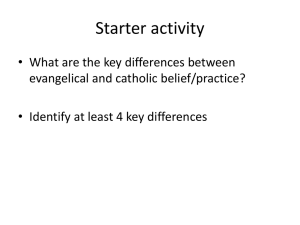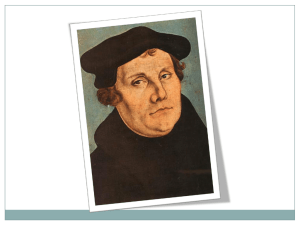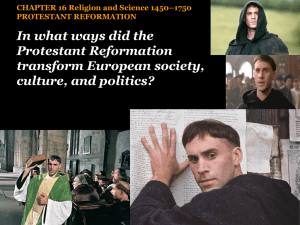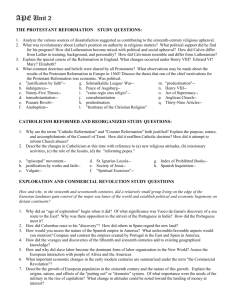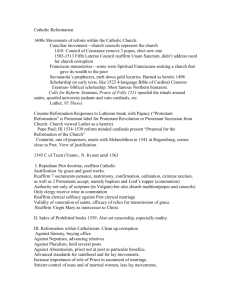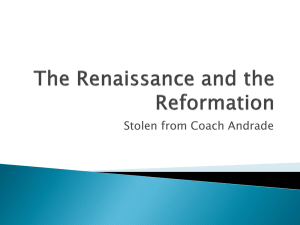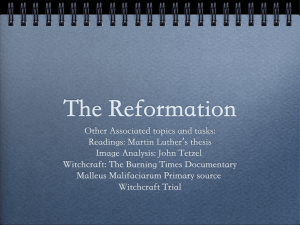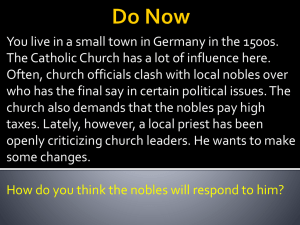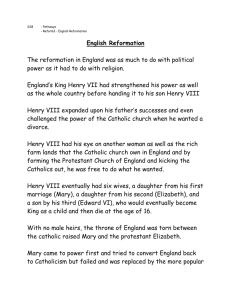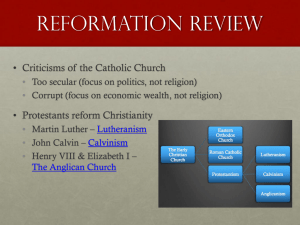Day 6 - Jacob Schulman
advertisement
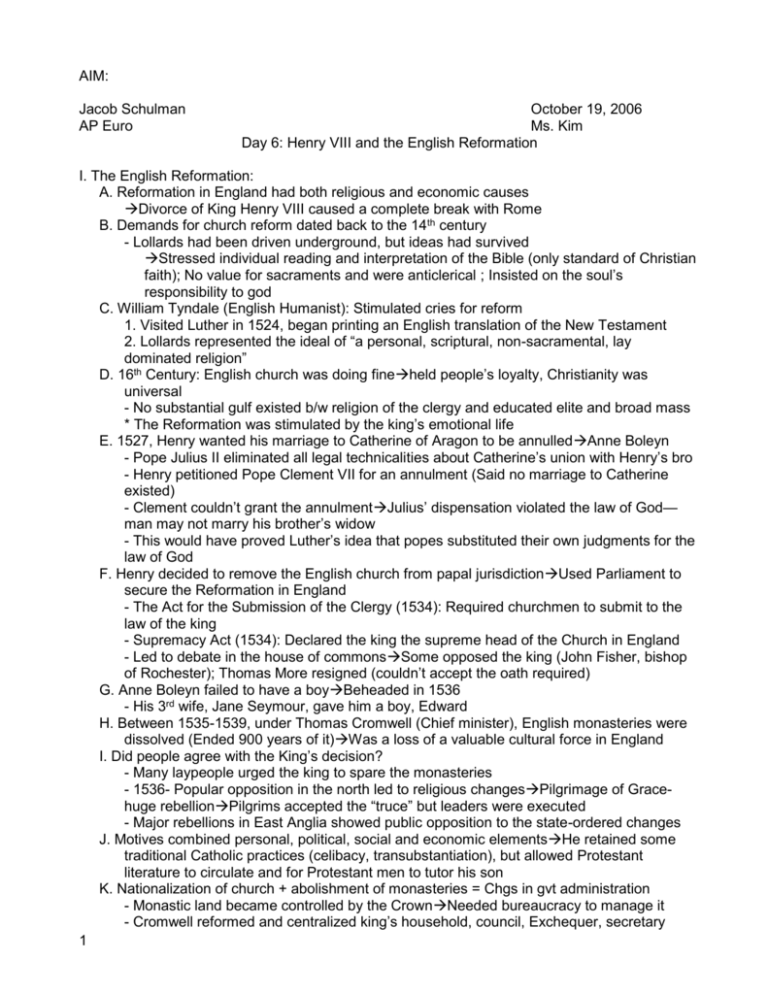
AIM: Jacob Schulman AP Euro October 19, 2006 Ms. Kim Day 6: Henry VIII and the English Reformation I. The English Reformation: A. Reformation in England had both religious and economic causes Divorce of King Henry VIII caused a complete break with Rome B. Demands for church reform dated back to the 14th century - Lollards had been driven underground, but ideas had survived Stressed individual reading and interpretation of the Bible (only standard of Christian faith); No value for sacraments and were anticlerical ; Insisted on the soul’s responsibility to god C. William Tyndale (English Humanist): Stimulated cries for reform 1. Visited Luther in 1524, began printing an English translation of the New Testament 2. Lollards represented the ideal of “a personal, scriptural, non-sacramental, lay dominated religion” D. 16th Century: English church was doing fineheld people’s loyalty, Christianity was universal - No substantial gulf existed b/w religion of the clergy and educated elite and broad mass * The Reformation was stimulated by the king’s emotional life E. 1527, Henry wanted his marriage to Catherine of Aragon to be annulledAnne Boleyn - Pope Julius II eliminated all legal technicalities about Catherine’s union with Henry’s bro - Henry petitioned Pope Clement VII for an annulment (Said no marriage to Catherine existed) - Clement couldn’t grant the annulmentJulius’ dispensation violated the law of God— man may not marry his brother’s widow - This would have proved Luther’s idea that popes substituted their own judgments for the law of God F. Henry decided to remove the English church from papal jurisdictionUsed Parliament to secure the Reformation in England - The Act for the Submission of the Clergy (1534): Required churchmen to submit to the law of the king - Supremacy Act (1534): Declared the king the supreme head of the Church in England - Led to debate in the house of commonsSome opposed the king (John Fisher, bishop of Rochester); Thomas More resigned (couldn’t accept the oath required) G. Anne Boleyn failed to have a boyBeheaded in 1536 - His 3rd wife, Jane Seymour, gave him a boy, Edward H. Between 1535-1539, under Thomas Cromwell (Chief minister), English monasteries were dissolved (Ended 900 years of it)Was a loss of a valuable cultural force in England I. Did people agree with the King’s decision? - Many laypeople urged the king to spare the monasteries - 1536- Popular opposition in the north led to religious changesPilgrimage of Gracehuge rebellionPilgrims accepted the “truce” but leaders were executed - Major rebellions in East Anglia showed public opposition to the state-ordered changes J. Motives combined personal, political, social and economic elementsHe retained some traditional Catholic practices (celibacy, transubstantiation), but allowed Protestant literature to circulate and for Protestant men to tutor his son K. Nationalization of church + abolishment of monasteries = Chgs in gvt administration - Monastic land became controlled by the CrownNeeded bureaucracy to manage it - Cromwell reformed and centralized king’s household, council, Exchequer, secretary 1 - New dept’s of state were set upGreater economic efficiency L. Edward VI (Henry’s Son): Strongly Protestant ideas had a significant impact on the religious life of the country - Book of Common Prayer (1549): Thomas Cranmer- In English, it included the Psalter, as well as order for all services of the Church of England M. Mary Tudor: Sharp move back to Catholicism (She was devoutly Catholic) - Restored Roman CatholicismMarriage to Philip of Spain was unpopular and her execution of Protestant peasants made her even more unpopular N. Elizabeth: Raised ProtestantCountry was sharply divided - Some wanted to keep Catholic ideas; Others wanted to get rid of them or “purify” the Church (Called- “Puritans”) - Elizabeth took a middle routeAccepted both (“Supreme Governor of the Church of England, Etc.”) - Elizabethan Settlement: Required outward conformity to the Church of England and uniformity in all ceremoniesEveryone had to attend - 1563- Thirty-Nine Articles: summary of the basic tenets of the Church of England During Elizabeth, the Anglican church was moving towards Protestantism - Services in English, no monasteries, clergy could marry; But bishops remained church officials and services were fairly traditional II. The Reformations Elsewhere: A. The Establishment of the Church of Scotland: 1. Political authority was the decisive influence of reform (Weak monarchy, strong nobles) 2. Disagreement among Mary Queen of Scots whose allies opposed reform; but the Scottish nobles supported it 3. John Know: Dominated the movement for reform in Scotland - Set to work reforming the church (Had worked with Calvin in Geneva) - 1560: Persuaded Scottish Parliament to create legislation ending papal authority - Mass was abolishedCreated the Presbyterian Church of Scotland (presbyters or “ministers” not bishops were governing it) - Strictly Calvinist in doctrine, simple service, emphasis on preaching - Book of Common Order: liturgical directory for the church - Many members maintained close relations with English Puritans B. Protestantism in Ireland: 1. Reformation added to the bitter antagonism of religion 2. People thought that the Irish were barbaric and they would have gotten rid of them if it didn’t cost that much 3. 1536: On orders from London, Irish Parliament (landlords and people of the Pale [area around Dublin]) approved English laws severing their church from Rome and making it controlled by the English king 4. Church of England was established on English pattern and it was adopted 5. Most remained Roman Catholic thoughMonasteries were secularized; Catholic property was sold and profits went to England C. Lutheranism in Sweden, Norway, and Denmark: 1. Monarchy took the religious initiative 2. 1520: Swedish nobleman Gustavus Vasa led a revolt against DenmarkSweden Independent - Wittenberg educated Swede Olaus Petri translated the NT into Swedish and organized the church along strictly Lutheran lines 3. Christian III, king of Denmark and Norway secularized church property and set up a Lutheran church 4. Norway adopted Lutheranism as its state religion under Danish influence 2

